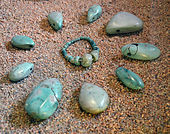Mané-er-Hroëk
The megalithic complex Mané-er-Hroëk ("Woman's Mountain"; sometimes also written Mané-er-Ruyk ) counts - together with the tumuli of Tumiac , Mané Lud and St. Michel - to the large tumuli in the Carnac area . It was already classified as a Monument historique in 1889 .
location
The tumulus and grotto of Mané-er-Hroëk are only a few meters above sea level and about 500 m southeast of the center of Locmariaquer in the Morbihan department in Brittany ( France ).
investment
tumulus
The Tumulus of Mané-er-Hroëk is a stone and earth mound about 100 m long, 60 m wide and about 8-10 m high, which is largely hidden under trees and bushes and thus gives the impression of a natural hill . During excavations in 1863, a crater was dug into the tumulus from above; the chamber was discovered in the process, but no human bones were found in it, so the term “burial chamber” should be used with caution.
chamber
Today's entrance to the Mané-er-Hroëk Chamber (width 2.80 m, depth 3.90 m, maximum height 1.75 m), which has been closed for thousands of years, was only dug into the tumulus in the 20th century. In their structure, i.e. H. A disorderly combination of unworked horizontal and vertical megaliths and quarry stone distinguishes it from all known buildings of this type in southern Brittany. The latter were built exclusively from smooth and possibly decorated orthostats; Rubble was only used to fill the gaps and for the cairn - but not for the structural wall structure. A stele broken into three pieces was found in the grotto, as well as a collection of over 100 stone axes and some pieces of jewelry.
ornamentation
The central motif of the stele - possibly brought here from an original location - (photo see web link) is a so-called 'shield idol', as can also be found in the Table des Marchand , in Gavrinis and on the large ceiling plate of the dolmen by Mané Rutual . Its most prominent feature is an appendage ( rostrum ) in the apex region. Within the frame there are wave patterns, above several ax motifs.
Stone axes
The more than 100 brightly polished jadeite axes found in Mané-er-Hroëk as well as some gemstones and pendants are now in the History Museum ( Château Gaillard ) in Vannes (short video see web link).
All of these things are likely to have been mainly cult objects or votive offerings and not objects of daily use.
On closer examination it was found that eleven of these axes are made of stone material, which occurs exclusively in the Alps; these stone axes must therefore be regarded as commodities and / or looted items.
meaning
While the tumulus of Mané-er-Hroëk shows clear similarities with other tumuli in the area (Mané Lud, Tumiac, Carnac), the grotto, which is made up of differently sized, unworked stones and is only roughly assembled in the rear part in its height, differs fundamentally from all other dolmen chambers in Brittany; possibly it was only created as a (provisional?) depository or votive room for the valuables (stone axes and jewelry) deposited here.
Dating
The complex of Mané-er-Hroëk is - because of the similarities with the other tumuli in the region - in the time around 4200 to 4000 BC. Dated. The treasure grotto is likely to have been inserted into the tumulus at a later date.
See also
literature
- Jean L'Helgouac'h: Les Idoles qu'on abat. In: Bulletin mensuel de la Société Polymatique du Morbihan. 110, 1983, ISSN 0767-9882 , pp. 57-68.
- Emmanuel Mens: Étude technologique des gravures de Mané er Hroëk (Locmariaquer, Morbihan): un nouveau cas de crosse transformée en hache dans l'art néolithique armoricain. In: Bulletin de la Société Préhistorique Française. Vol. 101, No. 1, 2004, pp. 105-116 .
- Damien Bonniol, Serge Cassen: Corpus descriptif des stèles ou fragments de stèle en orthogneiss. In: Serge Cassen (ed.): Autour de la Table. Explorations archéologiques et discours savants sur des architectures néolithiques à Locmariaquer, Morbihan. Laboratoire de recherches archéologiques (LARA) - University of Nantes, Nantes 2009, ISBN 978-2-86939-228-1 , pp. 702–734 , here pp. 713–719.
Web links
- Mané er-Hroëk - Photos of the tumulus and the burial chamber
- Mané er-Hroëk - short text + photo of the burial chamber
- Mané er-Hroëk - Photo of the stele
- Mané er-Hroëk - Photo of a stele
- Short video of the stone ax finds from Mané er-Hroëk (English)
Individual evidence
- ↑ Tumulus avec Dolmen du Mané-er-Hroëk, Locmariaquer in the Base Mérimée of the French Ministry of Culture (French)
- ↑ http://www.lda-lsa.de/landesmuseum_fuer_vorgeschichte/fund_des_monats/2008/januar/
Coordinates: 47 ° 33 ′ 46.2 " N , 2 ° 56 ′ 19.5" W.

